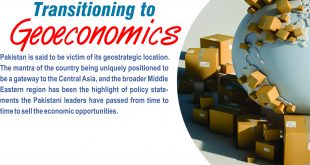By: Ammar Awais
The Challenge Ahead
In spite of the recent challenges faced by Pakistan’s economy, there is a sense of economic optimism in the country, driven by the $62 billion China-Pakistan Economic Corridor (CPEC). However, certain measures need to be taken to reap maximum benefits out of CPEC projects, one of which is to ensure robust, export-led investment in the manufacturing sector. According to experts, the annual outflows to the Chinese investors under CPEC projects are expected to average $2.5-3.0 billion in the coming years, while the IMF has estimated these outflows to peak at $4.5 billion by 2024, and then decline gradually. It is, hence, vitally important for Pakistan’s exports to grow at a steady pace to avoid further depletion of the country’s foreign exchange reserves, and to keep the balance of payments in check.
Exports Overview
Manufactured goods have continued to comprise a major portion of Pakistan’s exports, accounting for about 73 percent of the total export value in 2016-17. The textile industry, in particular, remains integral to Pakistan’s international trade. Various textiles-related commodities, such as cotton fabrics, cotton yarn and threads, knitwear and bedware are some of the biggest exports of the country. Other important exports include rice, leather, fish and fish preparations, fruits and vegetables, woollen rugs and carpets and sports goods.
Pakistan’s exports are largely concentrated in relatively few countries. The United States is currently the biggest export destination for Pakistani goods, accounting for over 16 percent of the country’s total export value in the second half of 2017. The US is followed by the United Kingdom, China, Afghanistan, and Germany as largest buyers of Pakistani products, collectively making up a further 28 percent of export value. Other important export destinations include Spain, the Netherlands, Belgium, Italy, UAE and Bangladesh.
Export Trends
In recent years, Pakistan has struggled to increase, or even maintain, the level of exports, leading to a highly negative balance of trade. In the fiscal year 2017-18, the country’s total exports were valued at $23.2 billion while the imports were recorded at nearly thrice that value at $60.9 billion, resulting in an unprecedented trade deficit of $37.7 billion, and seriously depleting our foreign exchange reserves. According to one report, 45 Pakistani products have lost competitiveness in the international market since 2013.
A close look at Pakistan’s export figures in recent decades reveals an inconsistent growth pattern. While the general trend for export value has been upward, the country has struggled to maintain consistent growth for a considerable length of time. However, it is in the past seven years or so that the export performance has been particularly disappointing. The total export value stood at $24.8 billion in 2010-11, but it failed to achieve any meaningful growth in the ensuing years, and declined sharply in 2015-16 to $20.8 billion. While the exports grew to $23.3 billion during 2017-18, this increase was drastically overshadowed by the much larger increase in imports – from $52.9 billion in 2016-17 to $60.9 billion in 2017-18, thus further deteriorating the balance of trade.
Read More: Growth momentum and imbalances in Pakistan’s economy
Causes of Decline in Exports
The primary reason for the recent decline in exports is the energy crisis that has hit the country over the past decade or so. The serious energy deficiency has caused many factories to shut down, while others have operated at minimum capacity, thus adversely affecting our production levels and the ability to export. It may also be argued that the quality of infrastructure in the country has not kept up with the regional standards, and obsolete technology continues to characterise many industries, which has reduced the competitiveness of our products internationally.
Our monetary policy in recent years has also conflicted with the balance of payments interests as currency appreciation in the past has also reduced our exports’ competitiveness in important international markets. Furthermore, there have been no meaningful efforts to broaden Pakistan’s export base, and heavy reliance on textile products alone continues to characterise our exports industry. The national tariff policy has led to heavy taxes being imposed on imported items that are used as inputs for producing export commodities; this has created a net negative impact on the balance of trade.
Consequences
The obvious consequence of the decline in exports in recent years is an ever-widening trade deficit which has depleted our foreign exchange reserves, and forced the government to devalue the currency by around 15 percent in a bid to boost exports. This has forced Pakistan to borrow heavily from foreign countries and agencies in recent years. The debt level has now reached a 15-year high at 72 percent of the GDP, and continued reliance on International Monetary Fund (IMF), which provides loans on interest, for financing the current account deficit seems inevitable. According to recent statistics, the currency devaluation has also added Rs1.190 trillion in public debt.
The Challenge Ahead
Reducing the current account deficit would be a major economic challenge for the new government, which cannot be achieved without substantially increasing exports over the next few years. A steady stream of high value exports is, in fact, the key to boosting our foreign currency reserves, and reducing our ever-growing foreign debt. Pakistan has untapped export potential worth $12.8 billion, according to the International Trade Centre, which the country would do well to exploit. The government would have to create an investor-friendly environment conducive to the production of exported commodities, and provide specific incentives to exporters.
One step already taken in this regard is the Prime Minister’s Exports Package introduced in January this year, which includes such benefits as the removal of customs duty and sales tax on the import of cotton to benefit textile exporters, and which was extended for a further three years in June. However, widening our export base should be a top economic priority for the new government as the textiles and garments industry accounted for 62 percent of Pakistan’s exports in 2017. At the same time, focus should be on controlling the country’s skyrocketing imports by implementing a long-term policy of industry promotion, rather than protection, hence paving the way for a steady, export-led growth.
 Jahangir's World Times First Comprehensive Magazine for students/teachers of competitive exams and general readers as well.
Jahangir's World Times First Comprehensive Magazine for students/teachers of competitive exams and general readers as well.



